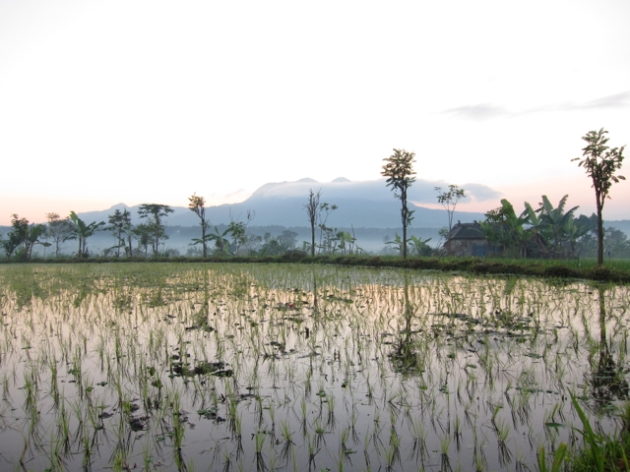With most Australian travellers heading to the famous beachside resorts in the south or making a ‘spiritual pilgrimage’ to Ubud, you’d think that was all there is to island. If you’re not in Bali to party, there’s so much more to do and see.
Here are 5 top tips for a relaxed tropical holiday in Bali, off the beaten track.
1. Tirtagangga & Karangasem, East Bali
Mount Agung is for more than climbing. At the base the mountain sits the serene villages of Tirtagangga (the home of the famous water palace) and neighbouring Karangasem. Small bed and breakfasts offer a quiet alternative for those who wish to avoid the crowds. A pre-breakfast walk in the paddy fields gives a glimpse of traditional village life and time for contemplation. This is the old, slow-paced Bali, away from the shopping malls, glitzy restaurants and beaches but still close enough for day trips to sample the other delights if you choose.
2. White Sand Beach, East Bali
On the coast between Candidasa and Karangasem is a hidden beach. Road access is a little rough and it’s best reached by hiring a driver. The East is not fabled for it’s beaches let alone sandy ones, so it’s an unexpected gem. It’s far enough off the main road to have no electricity, precluding any resorts for now. Small warungs dot the beach and for the price of a meal or a drink you can use a sun lounger and umbrella for as long as you like.
3. Lovina, North Bali
Sometimes referred to as ‘Mini Kuta’, Lovina is thankfully more sedate and less populated than it’s southern cousin. While it has a beach and the type culture that goes with it, my favourite find was the Warung Bambu restaurant and cooking school in near by Pemaron. Classes begin with a market visit to buy ingredients which is half the fun and ends with feasting on the fruits of your labour. We managed to have a lesson for two, at no extra cost, with a menu catering to our dietary preferences. If cooking’s not your thing, the restaurant is one of the best in the area and often books out at night.
4. Munduk, North Bali
The Dutch colonials favoured this northern hinterland when the equatorial climate got too much. Munduk is a lush cornucopia, growing coffee, cacao, cloves and other tropical delights. Get a local guide to take you for a walk around the plantations. The terrain can be steep and despite the elevation you’ll work up a sweat but it’s well worth it, with waterfalls to help you cool down. The township itself is quiet and tourist facilities are limited, which is just how I like it.
5. Seririt, North Bali
Right in the centre of the north coast, Seririt provides more upmarket and quieter options than Lovina’s more backpacker-ish feel. For now the area is off the main tourist radar, so it’s a delightful place to spend a week beside the pool, with a range of good quality resorts that make a great alternative to the madness of Ubud. There are also some black sand beaches and a host of options including snorkelling, diving and dolphin trips for the active or a soak at the local hot springs.
While Australians tend to congregate in the beachside party towns of Kuta, Legian and Seminyak, European tourists tend to flock to East and North Bali. So, even if these locations seem unfamiliar, don’t be surprised if accommodation is tight during the northern summer holiday months of July and August.
Have you got a favourite hideaway in Bali?







